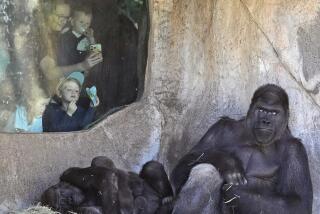If you enjoy sleeping at night instead of the day, thank the dinosaurs for going extinct
- Share via
Mammals were largely creatures of the night until the dinosaurs were killed off by an asteroid some 66 million years ago, a new study finds.
The findings, described in the journal Nature Ecology & Evolution, illuminate a pivotal transition in the history of Earth’s living things.
Scientists have long wondered whether ancient mammals may have been primarily nocturnal because dinosaurs dominated daytime activities — an idea known as the “nocturnal bottleneck hypothesis.”
Living mammal species today carry many signs of a literal dark past. For example, most mammals (except humans and many other primates) don’t have a fovea, an area in the eye’s retina that allows for the clearest vision. The shape of many mammals’ eyes also favors low-light sensitivity rather than the ability to see sharply.
That’s not to mention the heightened sense of smell, broader ability to hear and sophisticated whiskers that might have developed in many mammals “to compensate for insufficient visual information” in dark environments, the study authors pointed out.
Why were mammals such night owls? They may have had to avoid what the scientists called “antagonistic interactions” with dinosaurs, which typically operated in daylight. This flipped schedule may have been a lifesaver, keeping mammals from becoming furry midday snacks.
But the evidence for this idea is mostly indirect, the scientists pointed out. And trying to determine whether some long-dead mammal was nocturnal based on its fossil bone structure is tricky. After all, plenty of dayside mammals today have skull and eye shapes that look like those of a nocturnal animal.
To further probe this mystery, an international team of researchers compared the activity patterns for 2,415 different mammal species. They collected records from databases, research articles, field guides and encyclopedias about the behavior of these species, and determined whether their behavior fit into one of five patterns: nocturnal (active at night); diurnal (active in the day); cathemeral (active during both day and night); crepuscular (active only at twilight, around sunrise and sunset); and ultradian (active in cycles of a few hours at a time).
They focused on species in the first three categories — nocturnal, diurnal and cathemeral — and ran an analysis of the mammalian family tree. They found that the ancestors of today’s mammals were probably nocturnal, and probably stayed nocturnal until around the time that the dinosaurs died off.
“On balance, our evidence suggests that mammals remained nocturnal throughout the Mesozoic,” the authors wrote, referring to the era from about 252 million to 66 million years ago known informally as the Age of Reptiles.
Their analysis showed that the shift among some mammal species to diurnal activity happened after the extinction event. The earliest mammals that were strictly diurnal included simian primates, around 52 million to 33 million years ago. Though scientists can’t say that one caused the other, the study provides fresh circumstantial evidence.
However, it also appears that cathemeral activity (operating partly during both day and night) may have emerged much earlier, roughly 9 million years before the dinosaurs disappeared.
If dinosaurs still dominated the daytime, then why would some mammals start to shift into that space?
There are a few possible explanations. Perhaps cathemeral mammals were trying to reduce the chances of being eaten by other mammals at night. Perhaps the emergence and spread of flowering plants (and the insects that evolved with them) provided new opportunities for mammals to flourish.
But there’s also mounting evidence that dinosaurs were in decline long before the asteroid wiped them out. This may have opened opportunities for mammals to start inching into the daylight and, eventually, seizing the day.
Follow @aminawrite on Twitter for more science news and “like” Los Angeles Times Science & Health on Facebook.
MORE IN SCIENCE
Gun injuries in the U.S. have become more severe since the 1990s, study says
These orangutans are the newest species of great ape, and there are fewer than 800 left
Survey reveals surprising mismatch between perception and reality of obesity in America







